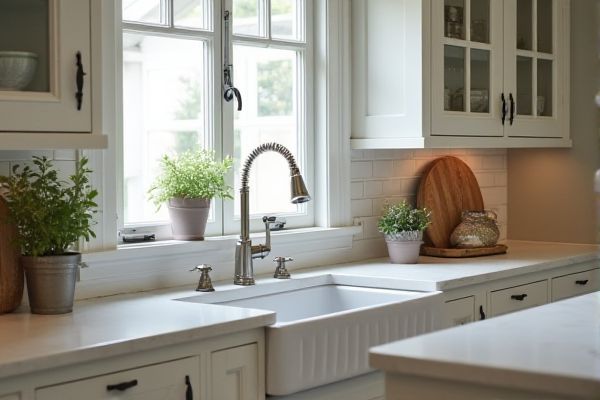
Farmhouse sinks provide a deep basin with an exposed front, ideal for handling large pots and adding rustic charm, while apron sinks often emphasize style with more compact designs suitable for smaller kitchens. Explore the rest of the article to discover which sink best suits your kitchen needs and aesthetic preferences.
Table of Comparison
| Feature | Farmhouse Sink | Apron Sink |
|---|---|---|
| Design | Large, deep basin with exposed front panel | Similar basin, often used interchangeably with farmhouse sink |
| Material Options | Fireclay, stainless steel, cast iron, composite granite | Same materials as farmhouse sinks |
| Installation | Wall-mounted with front apron exposed | Equivalent installation to farmhouse sinks |
| Size | Larger capacity, ideal for heavy-duty kitchen use | Sizes vary, generally similar to farmhouse sinks |
| Cost | Typically higher due to size and materials | Comparable cost to farmhouse sinks |
| Maintenance | Easy to clean, durable surfaces | Maintenance mirrors farmhouse sinks |
| Popularity | Classic farmhouse and rustic kitchen styles | Used interchangeably in modern farmhouse designs |
Introduction to Farmhouse and Apron Sinks
Farmhouse and apron sinks are large, deep basins designed for heavy-duty kitchen tasks, popular for their blend of functionality and rustic charm. Farmhouse sinks feature a front panel that extends slightly beyond the edge of the countertop, creating a bold visual statement, while apron sinks are often used interchangeably but can refer to a variety of styles with a similar overhanging front. Your choice depends on kitchen design preferences and the desired balance between traditional aesthetics and modern practicality.
Defining the Farmhouse Sink
The farmhouse sink, also known as an apron-front sink, features a deep basin with an exposed front panel that extends beyond the edge of the countertop. It is designed to accommodate large pots and pans, making it ideal for busy kitchens that require ample workspace and ease of access. Typically made from durable materials like fireclay, stainless steel, or porcelain, farmhouse sinks combine functionality with a rustic, timeless aesthetic.
Understanding the Apron Sink
An apron sink, often called a farmhouse sink, features an exposed front panel that extends beyond the edge of your countertop, offering a distinctive, rustic look. Unlike traditional sinks, its deep basin allows for easy washing of large pots and pans, enhancing kitchen functionality. Choosing an apron sink improves both your kitchen's aesthetic appeal and practical usability.
Design Aesthetics: Comparing Styles
Farmhouse sinks feature a deep basin with an exposed front panel, lending a rustic, vintage charm that complements traditional and country-style kitchens. Apron sinks, while similar in structure, often showcase sleeker lines and modern finishes, making them ideal for contemporary or transitional kitchen designs. Your choice between the two should align with the overall kitchen aesthetic and desired visual impact.
Material Options and Durability
Farmhouse sinks often feature durable materials like fireclay, stainless steel, and cast iron, offering resistance to scratches and stains with proper maintenance. Apron sinks, while commonly crafted from stainless steel or composite granite, tend to balance durability with a modern aesthetic, making them less prone to chipping compared to ceramic farmhouse styles. Understanding the material options and durability of both sink types helps you make an informed choice that suits your kitchen's style and longevity requirements.
Installation Differences
Farmhouse sinks require under-mount installation with a custom cut-out in the countertop to support their large, exposed front apron, demanding sturdy cabinetry reinforcement. Apron sinks, often used interchangeably with farmhouse designs, generally focus on the exposed front panel but can vary in installation methods, including drop-in options which simplify setup. Your decision impacts the complexity, time, and cost of installation, with farmhouse sinks typically needing professional skill due to their size and mounting style.
Functional Advantages and Disadvantages
Farmhouse sinks offer deep basins that accommodate large pots and pans, making them highly functional for heavy-duty kitchen tasks, but their exposed front can be challenging to install and may require customized cabinetry. Apron sinks provide a sleek, flush design that maximizes countertop space and enhances kitchen aesthetics, yet their shallower depth limits capacity and may cause splashing during use. You should weigh these functional advantages and disadvantages based on your kitchen workflow and design preferences.
Cost and Value Considerations
Farmhouse sinks typically range from $600 to $1,200, with installation costs averaging $200 to $500 due to their larger size and need for customized cabinetry. Apron sinks offer a similar price range but may incur higher labor expenses if retrofitting for unique dimensions. When evaluating cost versus value, farmhouse sinks provide a timeless, rustic appeal that enhances home aesthetics and resale value, while apron sinks offer versatile designs suited for both traditional and contemporary kitchens, balancing function with style.
Best Applications for Each Sink Type
Farmhouse sinks excel in kitchens with spacious layouts, providing a deep basin ideal for handling large pots and pans, making them perfect for avid home chefs and those who frequently entertain. Apron sinks are best suited for smaller or modern kitchens where sleek design and space efficiency are priorities, offering a streamlined look while maintaining functionality. Your choice between these sink types should consider kitchen size, design style, and how intensively you use your sink for cooking and cleaning tasks.
Conclusion: Choosing the Right Sink for Your Kitchen
Farmhouse sinks offer a deep basin and classic style perfect for heavy-duty kitchen tasks and rustic or traditional designs, while apron sinks provide a sleek front panel ideal for modern or minimalist kitchens prioritizing aesthetics. Consider durability, installation requirements, and countertop compatibility to match your kitchen's workflow and design. Selecting the right sink balances functionality with visual appeal to enhance overall kitchen efficiency and style.
 homyna.com
homyna.com